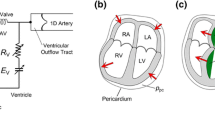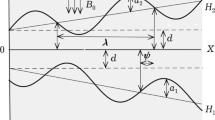Abstract
The unsteady flow of blood through stenosed artery, driven by an oscillatory pressure gradient, is studied. An appropriate shape of the time-dependent stenoses which are overlapped in the realm of the formation of arterial narrowing is constructed mathematically. A msathematical model is developed by treating blood as a non-Newtonian fluid characterized by the Oldroyd-B and Cross models. A numerical scheme has been used to solve the unsteady nonlinear Navier-stokes equations in cylindrical coordinate system governing flow, assuming axial symmetry under laminar flow condition so that the problem effectively becomes two-dimensional. Finite difference technique was used to investigate the effects of parameters such as pulsatility, non-Newtonian properties and the flow time on the velocity components, the rate of flow, and the wall shear stress through their graphical representations quantitatively at the end of the paper in order to validate the applicability of the present improved mathematical model under consideration.
Similar content being viewed by others
References
G. Pontrelli, Pulsatile blood flow in a pipe, Computers & Fluids. 27 (1998) 367–380.
P. K. Mandal, S. Chakravarty, A. Mandal and N. Amin, Effect of body acceleration on unsteady pulsatile flow of non-Newtonian fluid through a stenosed artery, Applied Mathematics and Computation. 189 (2007) 766–779.
R. L. Whitmore, Rheology of circulation, Pergamon Press, Oxford, 1968.
M. J. Manton, Low Reynolds number flow in slowly varying axisymmetric tubes, J. Fluid Mech. 49 (1971) 451–459.
G. Porenta, G. F. Young and T. R. Rogge, A finite element model of blood flow in arteries including taper, branches and obstructions, J. Biomech. Eng. 108 (1986) 161–167.
D. S. Sankar and K. Hemalatha, Pulsatile flow of Herschel-Bulkley fluid through stenosed arteries- A mathematical model, Non-linear Mechanics. 41 (2006) 979–990.
D. L. Fry, Measurements of pulsatile blood flow by the computed pressure gradient technique, IRE Trans. Med. Electron. ME-6 (1959) 259–264.
D. Liepsch, an introduction to biofluid mechanics basis models and application, J. Biomech. 35 (2002) 415–435.
P. Chaturani and V. Palanisamy, Pulsatile flow of blood with periodic body acceleration, Int. J. Eng. Sci 29 (1991) 113–121.
P. Chaturani and Issac A. S. A. Wassf, Blood flow with body acceleration forces, Int. J. Eng. Sci. 33 (1995) 1807–1820.
V. K. Sud and G. S. Sekhon, Arterial flow under periodic body acceleration, Bull. Math. Biol. 47 (1985) 35–52.
J. B. Shukla, R. S. Parihar and S. P. Gupta, Biorheological aspects of blood flow through artery with mild stenosis: effects of peripheral layer, Biorheology 17 (1980) 403–410.
P. Chaturani and R. Ponnalagar Samy, A study of non-Newtonian aspects of blood flow through stenosed arteries and its applications in arterial diseases, Biorheology 22 (1985) 521–531.
A. C. Burton, Introductory text, In Physiology and Biophysics of the circulation, Year Book Medical Publisher, Chicago, IL, (1966).
A. Sequeira and J. Janela, An overview of some mathematical models of blood rheology, A Portrait of State-of-the-Art Research at the Technical University of Lisbon, (2007) 65–87.
S. Chien, S. Usami, R. J. Dellenback and M. I. Gregersen, Blood viscosity: Influence of erythrocyte deformation, Science 157 (3790), pp. 827–829.
M. M. Cross, Rheology of non-Newtonian fluids: a new flow equation for pseudo-plastic systems, J. Colloid Sci., 20, 1965, pp. 417–437.
P. J. Carreau, PhD Thesis, University of Wisconsin, Madison, 1968.
C. W. Macosko, Rheology principles, measurements and applications, VCH publication (1993).
G. B. Thurston, Viscoelasticity of human blood, Biorheology 12 (1972) 1205–1217.
W. M. Phillips and S. Deutsch, Toward a constitutive equation for blood, Biorheology 12 (1975) 383–389.
K. K. Yelesvarapu, M. V. Kameneva, K. R. Rajagopal and J. F. Antaki, The flow of blood in tubes: theory and experiment, Mech. Res. Comm, (25) 3, 1998, pp. 257–262.
P. K. Mandal, An unsteady analysis of non-Newtonian blood flow through tapered arteries with stenosis, Int.J. Non-Linear Mechanics 40 (2005) 151–164.
T. J. Pedley, The Fluid mechanics of large blood vessels, Cambridge University Press, London, 1980.
J. Tannehill, D. Anderson and R. Pletcher, Computational Fluid Mechanics and Heat Transfer, Philadelphia 1984.
Author information
Authors and Affiliations
Corresponding author
Additional information
This paper was recommended for publication in revised form by Associate Editor Yang Na
Ashkan Javadzadegan received his B.S. in Mechanical Engineering from University of Tabriz, Iran, in 2006. He then received his M.S. degree from University of Tehran, Iran in 2008. His research interests include rheology, heat transfer and Biomass.
Mostafa Esmaeili received his B.S. in Mechanical Engineering from University of Buali Sina Hamadan, Iran, in 2006. He then received his M.S. degree from University of Tehran in 2008. He has been accepted into the Ph.D program at Sharif University of Technology in 2009. His research interests include Biofluidics, rheology, micro and nanofluidics and MHD flow.
Sahand Majidi received his B.S. in Mechanical Engineering from Khaje Nasir Toosi University of Technology (K.N.T.U), Tehran, Iran, in 2006. He then received his M.S. degree from the University of Tehran in 2008. His research interests include rheology, heat transfer and porous media.
Babak Fakhimghanbarzadeh received his B.S. in Mechanical Engineering from University of Tabriz, Iran, in 2006. He then received his M.S. degree from Sharif University of Technology in 2008. His research interests include Exergoeconomics, Biomass.
Rights and permissions
About this article
Cite this article
Javadzadegan, A., Esmaeili, M., Majidi, S. et al. Pulsatile flow of viscous and viscoelastic fluids in constricted tubes. J Mech Sci Technol 23, 2456–2467 (2009). https://doi.org/10.1007/s12206-009-0713-9
Received:
Revised:
Accepted:
Published:
Issue Date:
DOI: https://doi.org/10.1007/s12206-009-0713-9




